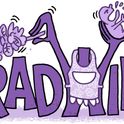Dance theatre of Harlem is back, proving that ballet doesn't have to be a uniform line-up of white faces. Its 70-year-old co-founder Arthur Mitchell was the first black dancer to perform on a ballet stage as a principal at a time when black dancers were pretty much limited to tap or jazz. He was given his chance by George Balanchine, who brought him into New York City Ballet and in 1957 cast him in Agon, where he partnered a white woman in a pas de deux of seething eroticism. Little has changed since: ballet companies have failed to become colour-blind.
Mitchell launched DTH in 1969 to dispel the notion that black people could not dance classical ballet. But it does not stand for ballet apartheid. After realising that white people were to be found on the sidewalks even in black-ghetto Harlem, Mitchell decided that DTH needed to reflect society. So although black people form the company's majority, other races are there as well. DTH says that a corps de ballet does not have to be uninterrupted black - or white - to make dance magic. Its latest visit to Britain is the cue for another bout of heart-searching about the deal here. In 1991, a London initiative was started, modelled on DTH's residences in US cities. The result was Chance to Dance, a scheme for children operated under the aegis of the Royal Opera House. It is still in business. But apart from the occasional black face - and guest appearances by the Cuban superstar Carlos Acosta - you wouldn't know it from looking at our ballet companies.
Darryl Jaffray, director of education at ROH, remains committed to moulding a ballet culture that mirrors today's society. She says that Chance to Dance has targeted areas like Peckham and Lambeth to offer free ballet classes to children. Several thousand children have gone through the programme, some continuing on into vocational schools. (The Royal Ballet School has three of them.) So is it just a question of time before they eventually filter into companies? It would seem not. In the US, where DTH has been active far longer, the composition of companies is no different from ours. DTH enlists plenty of black dancers. But other ballet companies still stick to the token one or two - usually male, since men are at a premium in ballet.
What is operating here is the old orthodoxy, the idea that ballet was created in the image of a white culture, that it was the entertainment of kings, its shapes determined by court aesthetics. And so the ballet establishment still privately believes that the black physique is too muscle-bound for ballet's willowy curves, the feet too stiff for its tapering lines. The black physique, they sense, is suited to the freer, perpetually reinvented shapes of modern dance, which has always welcomed multiple ethnicities.
The ballet mindset that undervalues black bodies is just not seeing them properly. Brenda Edwards, a black former dancer with both the London Contemporary Dance Theatre and English National Ballet describes stereotypes about stiff feet as lazy and patronising. She resents the implication that a dancer's choice of form should be determined by colour and, for the past three years, has organised Hip, an annual winter festival for performers of colour in the whole spectrum of dance, from hip hop to ballet. She would prefer to see money and effort focused on developing a British infrastructure for black dance rather than on inviting Americans. Meanwhile, DTH is a valuable exemplar of what could be: an image of energy, enthusiasm and beauty.
Dance Theatre of Harlem is at Sadler's Wells Theatre from 30th March to 10th April, then touring












